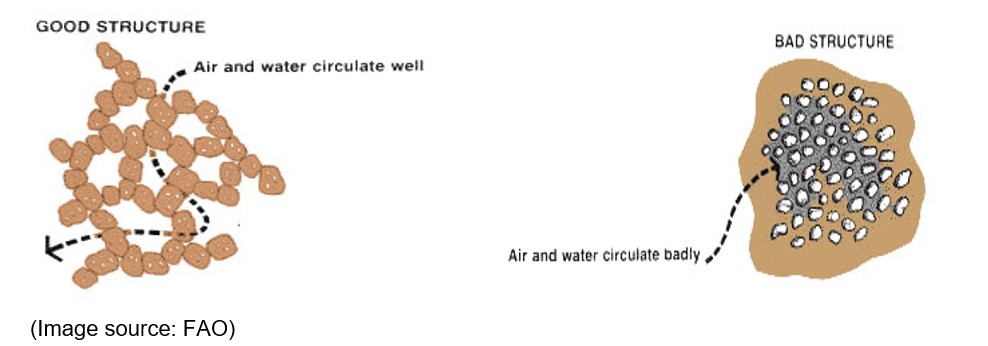Soil having the capacity to function as a vital living ecosystem, sustains plants, animals, humans and microbes. It consists of inorganic particles and organic matter. Soil is the source of water and nutrients to the plants and also provides structural support. Healthy soils supply the essential nutrients, water, oxygen and root support that our food-producing plants need to grow and flourish(International Year of Soils 2015, FAO).
Soil also teams up with the microbes converting dead and decaying matter as well as minerals to plant nutrients controlling plant disease, insect and weed pests; improving soil structure with positive effects for soil water and nutrient holding capacity, and ultimately improving crop production. A healthy soil also contributes to mitigating climate change by maintaining or increasing its carbon content. Extractive farm practices such as higher use of chemicals and burning of crop residues are degrading Indian soil and jeopardizing the health of its citizens, says Rattan Lal, soil scientist, and winner of the 2020 World Food Prize(Mint, July2020).
When the soil is exploited for crop production without restoring the organic matter and nutrient contents, the nutrient cycles are broken, soil fertility declines and the balance in the agro-ecosystem is destroyed.

Nutritious and good quality food and animal fodder can only be produced if our soils are healthy living soils. In many countries, like India, intensive crop production has depleted the soil, jeopardizing the soil’s productive capacity and ability to meet the needs of future generations. Looking at the stats from 2019-20 Soil Health Survey,GOI, 55% of the country’s soil is deficient in nitrogen, 42 % in phosphorus and 44 % in organic carbon. And to blame this health crisis of soil is extractive agricultural practices going on for years, heavy chemical and fertilizer use, and poor irrigation management.
Farming practices and incentives have prioritized yield optimisation over long-term soil health, and continue to do so. The ideal n-p-k use ratio is 4:2:1, but has gone from 6:2.4:1 in 1990 to 6.7:2.7:1 in 2016, according to a 2017 report by the Fertilizer Association of India. The situation is grimmer in agriculturally important states like Punjab and Haryana where the ratio is as high as 31.4:8.0:1 and 27.7:6.1:1 respectively. Since increasing cultivation area is difficult, the pressure is on increasing the productivity of existing cultivated areas. However, in our urge to grow more food to feed the ever growing population, soils have been particularly misused to an extent that it is now affecting the state of our health.

In India, 51% of food commodities produced are contaminated with pesticide residues and out of these, 20% have pesticides residues above the maximum residue level values on a worldwide basis(https://pubmed.ncbi.nlm.nih.gov/15138033/). Currently, India is the largest producer of pesticides in Asia and ranks twelfth in the world for the use of pesticides. The 54th report of the Parliamentary Standing Committee of Agriculture(2017-18) says that skewed subsidy policy in favour of urea and high prices of other fertilizers are behind the imbalance in the use of fertilisers in the country.
Malnourished soil, including deficiency in macro and micronutrients, leads to the underdevelopment of plants and reduced yields and nutritional value of the crops grown in that soil. The chronic lack of micronutrients, due to nutrient-deficient soils and nutrient deficient crops, causes hidden hunger, which has already affected over 2 billion people worldwide(https://www.thelancet.com/action/showPdf?pii=S2214-109X%2822%2900421-1). The overuse and misuse of fertilizers lead to harmful nutrient surpluses in agricultural fields and cause a number of environmental problems, including the deterioration of water quality and the eutrophication of aquatic ecosystems, exacerbation of climate change due to increased release of greenhouse gasses and soil pollution, and crop failure. In other parts of the world, undersupply of nutrients causes plants to mine existing nutrients, leading to lower yields and micronutrient deficiencies in crops.
Lack of awareness and knowledge of the health and quality of soil have led our farmers to use nutrients and fertilizers in an inappropriate manner. More than a third of the world’s soil is already degraded, and the IPCC estimates that could rise to 90% by 2050 if nothing is done (world economic forum).
Soil degradation is one of the most serious consequences of conventional agriculture. Soil is subject to a series of degradation processes Estimates indicate that 38% of the land cultivated in the world has been damaged to some degree by post-WWII agricultural practices (Gliessman 1998). We need to support farmers to adopt sustainable soil management practices that are adapted to the country and are the result of a combination of scientific and local knowledge. This will restore the balance and harmony of our soils.
Investing in healthy soils brings many benefits, including these climate-related ones. It will increase productivity, healthier food production, water storage and biodiversity conservation, making agrifood systems more sustainable and resilient.
We can improve soil health, water absorption and retention, and nutrient cycling by supporting the soil life. The best can be done by adding organic matter to the soil. Organic matter has a significant impact on soil properties, containing living organisms, fresh residues and molecules from decomposed residues of carbon-based compounds found within natural and engineered environments.
Healthy soil is the root source of a livelihood that sustains farmers and communities all around the world as good soil produces good crops that deliver a good income that enables families to flourish. Soil plays a significant role in the carbon cycle and climate regulation. Healthy soil contains organic matter, which stores carbon and helps mitigate climate change by reducing greenhouse gas emissions. It acts as a carbon sink, absorbing carbon dioxide from the atmosphere.
By maintaining soil health, we protect this finite and valuable resource from degradation and loss. Soil erosion, pollution, compaction, and salinization are some of the threats that can diminish soil quality and productivity. Through sustainable land management practices like crop rotation, cover cropping, terracing, and conservation tillage, we can minimize soil degradation and preserve its fertility for future generations.
Overall, promoting and preserving soil health is essential for sustainable agriculture, biodiversity conservation, water management, climate regulation, and the long-term well-being of ecosystems and human societies.

